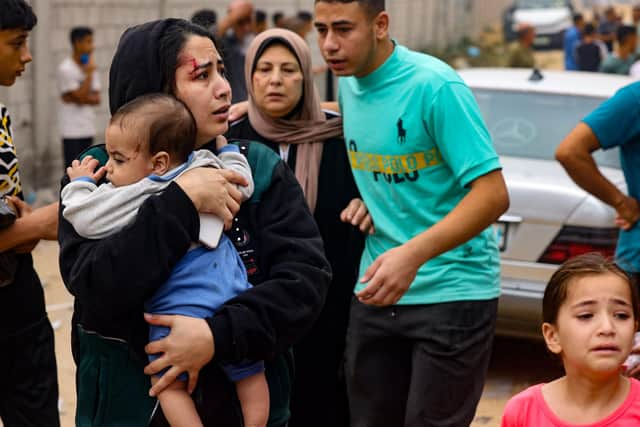Israel Hamas war: Israeli warplanes carry out air strikes near Gaza's largest hospital
Israeli warplanes carried out air strikes early on Sunday near Gaza’s largest hospital which is packed with patients and Palestinians seeking shelter.
Israel has said Gaza’s militant Hamas rulers have a command post under the hospital, without providing much evidence.
Advertisement
Hide AdAdvertisement
Hide AdThe strikes came a day after Israeli Prime Minister Benjamin Netanyahu announced a “second stage” in Israel’s war on Hamas, three weeks after Hamas launched a brutal incursion into Israel.


Ground forces pushed into Gaza over the weekend as Israel pounded the territory from air, land and sea.
The bombardment – described by Gaza residents as the most intense of the war – knocked out most communications in the territory late on Friday, largely cutting off the besieged enclave’s 2.3 million people from the world.
Communications were restored to many people in Gaza early on Sunday, according to local reports.
In a sign of growing chaos in Gaza, the UN agency for Palestinian refugees said thousands of people broke into its Gaza aid warehouses to take food and other “basic survival items” like hygiene products.
Thomas White, the agency’s director in Gaza, said the break-in was “a worrying sign that civil order is starting to break down”.
The agency provides basic services to hundreds of thousands of people in Gaza. Its schools across the territory have been transformed into packed shelters housing Palestinians displaced by the conflict.
Residents said the latest air strikes destroyed most of the roads leading to Shifa Hospital in Gaza City, in the northern half of the territory which Israel has told people to evacuate.
Advertisement
Hide AdAdvertisement
Hide AdIsrael says most residents have fled to the south, but hundreds of thousands remain in the north. Tens of thousands are sheltering in Shifa, which is also packed with patients wounded in strikes.
“Reaching the hospital has become increasingly difficult,” Mahmoud al-Sawah, who is sheltering in the hospital, told the Associated Press over the phone. “It seems they want to cut off the area.”
Another Gaza City resident, Abdallah Sayed, said the Israeli bombing over the past two days was “the most violent and intense” since the war started.
The Israeli military had no immediate comment about reports of strikes near Shifa.
The army recently released computer-generated images showing what it said were Hamas installations in and around Shifa Hospital.
Israel has made similar claims before but has not substantiated them.
The Hamas government dismissed the allegations as “lies” and said they were “a precursor for striking this facility”.
On Saturday, the Israeli military released grainy images showing tank columns moving slowly in open areas of Gaza, apparently near the border, and said warplanes had bombed dozens of Hamas tunnels and underground bunkers.
Advertisement
Hide AdAdvertisement
Hide AdThe escalation ratcheted up domestic pressure on Israel’s government to secure the release of some 230 hostages seized in the October 7 rampage, when Hamas fighters stormed from Gaza into nearby Israeli towns and gunned down civilians and soldiers.
Family members met with Mr Netanyahu on Saturday and expressed support for an exchange for Palestinian prisoners held in Israel.
Hamas’s top leader in Gaza, Yehia Sinwar, said the Palestinian militant groups “are ready immediately” to release all hostages if Israel releases the thousands of Palestinians held in Israeli prisons.
Rear Admiral Daniel Hagari, an Israeli military spokesman, dismissed the offer as “psychological terror”.
Mr Netanyahu said during a televised news conference that Israel is determined to bring back all the hostages, and he maintained the expanding ground operation “will help us in this mission”.
He said he could not reveal everything that is being done due to the sensitivity and secrecy of the efforts.
“This is the second stage of the war, whose objectives are clear: to destroy the military and governmental capabilities of Hamas and bring the hostages home,” he said, answering questions from journalists for the first time since the war began.
Mr Netanyahu acknowledged the October 7 “debacle” in which more than 1,400 people were killed will need a thorough investigation, adding: “Everyone will have to answer questions, including me.”
Advertisement
Hide AdAdvertisement
Hide AdThe Israeli military said it was gradually expanding its ground operations inside Gaza, while stopping short of calling it an all-out invasion.
Casualties on both sides are expected to rise sharply as Israeli forces and Palestinian militants battle in dense residential areas.
“We are proceeding with the stages of the war according to an organised plan,” Mr Hagari, the military spokesman, said.
The comments hinted at a strategy of staged escalation, instead of a massive and overwhelming offensive.
Despite the Israeli offensive, Palestinian militants have continued firing rockets into Israel with the constant sirens in southern Israel a reminder of the threat.
The Palestinian death toll in Gaza rose Saturday to just over 7,700 people since the war began, with 377 deaths reported since late on Friday, according to the Gaza Health Ministry. Most of those killed have been women and minors, the ministry said.
Ministry spokesman Ashraf al-Qidra told reporters the disruption of communications had “totally paralysed” the health network. Residents had no way of calling ambulances, and emergency teams were chasing the sounds of artillery barrages and air strikes.
An estimated 1,700 people remain trapped beneath the rubble, according to the Health Ministry, which bases its estimates on distress calls it received.
Comments
Want to join the conversation? Please or to comment on this article.